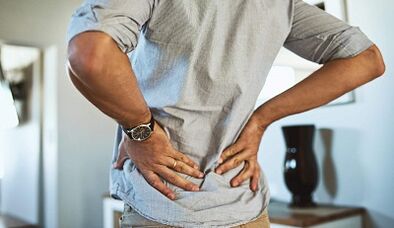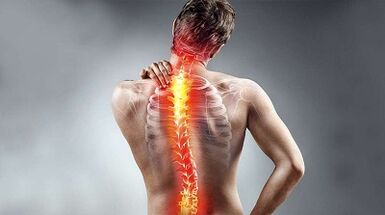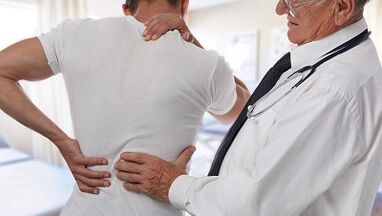
The pain in the back may occur at any age, but more often occurs between 35 and 55 years.The pain in the spine is associated with the way of working our bones, muscles, intervertebral discs, ligaments, tendits and nerves.
The pain in the spine can be caused by problems with the verts, disks, ligaments around the spinal pillars and disks, spinal cords, the muscles in the back, internal bodies in the areas of abdominal and cardiac areas.Also, aortic diseases, chest tumors and spine inflammation in the upper back can be the cause of pain in the upper back.
Risk factors
The presence of risk factors increases the probability of state development.For example, obesity significantly increases the risk of different type diabetes.
The following factors are connected to increasing the risk of back pain.
- office work;
- work associated with constant stress;
- Pregnancy - Pregnant women often suffer from spine pain;
- Sedentary lifestyle;
- Age;
- depression;
- Obesity / surplus weight;
- Smoking;
- Hard physical exercises;
- Heavy physical work.
Signs and symptoms of back pain
The symptom is what the patient feels, while the doctor can notice the sign.For example, pain is a symptom, while the rash is a sign.
The main symptom of pain in the spine is pain in any part of the back.Sometimes pain extends to buttocks and legs or on shoulder and arms.
You must immediately contact your doctor if the pain in your spine follows any of the following characters:
- Weight loss;
- High temperature (fever);
- Back pain does not make it easier after vacation;
- painful pain;
- Lowering the pain below the knees;
- Presence of fresh spine injuries;
- Urine incontinence (even small part);
- Difficulty urinating - urine is difficult;
- Fecal incontinence - loss of control over the process of defecation;
- stiffness in the field of genital;
- stiffness in the anus;
- Stiffness in buttocks.

Sign up for the advice of experts if you are one of these groups:
- people under 22 years or older than 55;
- patients who took steroids for several months;
- Cancer patients;
- Patients who once had cancer;
- Patients with low immunity.
The causes of back pain
The human spine is a complex structure consisting of muscles, ligaments, tendons, disks and bones.Intervertebral discs are located between each pair of vertebrae and function as shock absorbers by friction.Problems with any of these components can lead to pain in the spine.In some cases, the causes of pain cannot be established.
Stretch
The most common causes of pain in spine are:
- Stretched muscles;
- Outstretched ligaments;
- Raising heavy objects in the wrong loan;
- Raising the overhead subject;
- the result of a sharp and clumsy movement;
- Muscular spasm.
Structural problems
The following structural problems can lead to pain in the spine:
- Intervertebral disk protenity.The rupture of the external disk sheath leads to bulging its internal facilities outwards.This can lead to nerve stab and, as a result, pain;
- An intervertebral disk hernia- sting of the internal contents of the low size disk;
- Sciatica- acute and shooting pain, which radiates in the buttocks and the back surface of the leg caused by a protrusion or hernia of the intervertebral disk, compression of the nerve;
- arthritis- Patients with osteoarthritis usually have problems with thigh joints, lumbar spine, knees and hands.In some cases, spinal channels can occur, because space around the spinal cord is narrowed;
- Anomalan bandage spine- If the spine folds in an unusual way, the patient is more likely to suffer from the pain in the spine.An example of an abnormal bend is Scoliosis, in which the spine bends aside;
- osteoporosis- Bones, including vertebrae, become fragile and porous, leading to increasing their fragility.

Below are some other causes of pain in spine:
- Horse syndrome- Ponytail is a bunch of nerve roots in which the spine is branched.People with horse syndrome for horses feel a blunt pain in the lumbar spine and buttocks.There may also be losing the sensitivity of the buttocks, genitals, thighs.Sometimes people with horse syndrome suffer from urinary and / or feces;
- Spine cancer- The tumor located in the spine can squeeze the nerve, leading to pain;
- Spine infection- If the patient has a high body temperature, and there is a painful hot area on his back, then it may indicate the spine infection;
- Other infections- inflammation of the pelvic authorities in women, as well as blister and kidney infections can also cause back pain;
- Sleep disorders- persons with sleep disorders more often experience pain in the spine compared to the general population;
- shingles- an infection that can affect the nerves;
- Inappropriate mattress- If the mattress does not support certain parts of the body and does not ensure the steady position of the rear, there is a risk of pain in spine.
Also, the cause of pain in the spine can be certain movements or body position, such as extended driving, cough and so on.
What to do when injury hurts
If you experience pain in your spine for more days, then the following tips will help you reduce pain and discomfort and speed up recovery:

- Be as active as possible;
- If necessary, use via-packs against pain;
- Use hot and cold compresses.A hot water bottle and a bag of frozen vegetables will be made.
Despite the fact that it is difficult to stay optimistic when you suffer from pain, try not to lose your heart.This will speed up the recovery process.
With prolonged pain in the spine, which does not pass within six weeks, you must contact your doctor.The doctor will compile medical history, perform the test and if necessary, will focus on additional studies.The doctor may prescribe a radiograph in case of suspicion of bone system or osteoarthritis, CT (calculated tomography) or MRI (magnetic resonant tomography) in the case of suspicious intervertebral hernia or any other problems associated with soft tissues or nerves.In such a situation, MRI is the best choice.The doctor can advise you to submit some laboratory tests or measures of the electrical activity of nerves (EMG).
After making diagnosis, the doctor prescribes treatment.For most cases there is sufficient conservative treatment that may include:
- Special exercises;
- reflexology;
- Spinal extension;
- Massage.
In severe cases, the question of surgery can be asked.The surgeon will help you select the appropriate method, and also advise on possible complications.Some time after the operation, the undergraduate treatment of the spine is recommended.Note that the spine operations are quite dangerous, because the operating space is close to nerves.















































